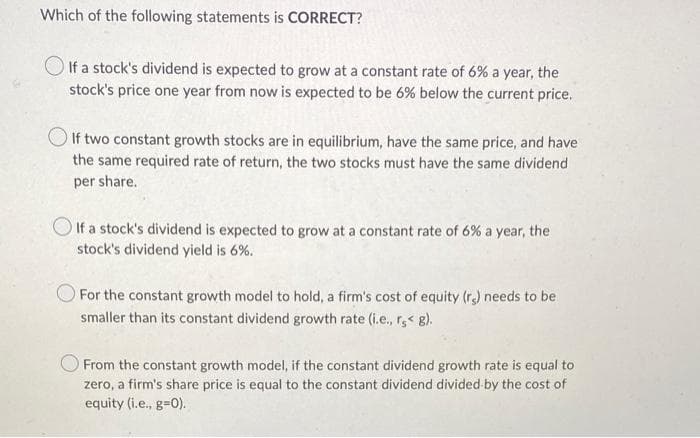Which of the following statements is CORRECT? If a stock's dividend is expected to grow at a constant rate of 6% a year, the stock's price one year from now is expected to be 6% below the current price. If two constant growth stocks are in equilibrium, have the same price, and have the same required rate of return, the two stocks must have the same dividend per share. If a stock's dividend is expected to grow at a constant rate of 6% a year, the stock's dividend yield is 6%. For the constant growth model to hold, a firm's cost of equity (rs) needs to be smaller than its constant dividend growth rate (i.e., r, g).
Which of the following statements is CORRECT? If a stock's dividend is expected to grow at a constant rate of 6% a year, the stock's price one year from now is expected to be 6% below the current price. If two constant growth stocks are in equilibrium, have the same price, and have the same required rate of return, the two stocks must have the same dividend per share. If a stock's dividend is expected to grow at a constant rate of 6% a year, the stock's dividend yield is 6%. For the constant growth model to hold, a firm's cost of equity (rs) needs to be smaller than its constant dividend growth rate (i.e., r, g).
Fundamentals of Financial Management, Concise Edition (with Thomson ONE - Business School Edition, 1 term (6 months) Printed Access Card) (MindTap Course List)
8th Edition
ISBN:9781285065137
Author:Eugene F. Brigham, Joel F. Houston
Publisher:Eugene F. Brigham, Joel F. Houston
Chapter9: Stocks And Their Valuation
Section: Chapter Questions
Problem 6DQ
Related questions
Question

Transcribed Image Text:Which of the following statements is CORRECT?
If a stock's dividend is expected to grow at a constant rate of 6% a year, the
stock's price one year from now is expected to be 6% below the current price.
If two constant growth stocks are in equilibrium, have the same price, and have
the same required rate of return, the two stocks must have the same dividend
per share.
If a stock's dividend is expected to grow at a constant rate of 6% a year, the
stock's dividend yield is 6%.
For the constant growth model to hold, a firm's cost of equity (re) needs to be
smaller than its constant dividend growth rate (i.e., rs< g).
From the constant growth model, if the constant dividend growth rate is equal to
zero, a firm's share price is equal to the constant dividend divided by the cost of
equity (i.e., g=0).
Expert Solution
This question has been solved!
Explore an expertly crafted, step-by-step solution for a thorough understanding of key concepts.
Step by step
Solved in 2 steps

Knowledge Booster
Learn more about
Need a deep-dive on the concept behind this application? Look no further. Learn more about this topic, finance and related others by exploring similar questions and additional content below.Recommended textbooks for you

Fundamentals of Financial Management, Concise Edi…
Finance
ISBN:
9781285065137
Author:
Eugene F. Brigham, Joel F. Houston
Publisher:
Cengage Learning

Fundamentals of Financial Management, Concise Edi…
Finance
ISBN:
9781305635937
Author:
Eugene F. Brigham, Joel F. Houston
Publisher:
Cengage Learning

Fundamentals Of Financial Management, Concise Edi…
Finance
ISBN:
9781337902571
Author:
Eugene F. Brigham, Joel F. Houston
Publisher:
Cengage Learning

Fundamentals of Financial Management, Concise Edi…
Finance
ISBN:
9781285065137
Author:
Eugene F. Brigham, Joel F. Houston
Publisher:
Cengage Learning

Fundamentals of Financial Management, Concise Edi…
Finance
ISBN:
9781305635937
Author:
Eugene F. Brigham, Joel F. Houston
Publisher:
Cengage Learning

Fundamentals Of Financial Management, Concise Edi…
Finance
ISBN:
9781337902571
Author:
Eugene F. Brigham, Joel F. Houston
Publisher:
Cengage Learning


EBK CONTEMPORARY FINANCIAL MANAGEMENT
Finance
ISBN:
9781337514835
Author:
MOYER
Publisher:
CENGAGE LEARNING - CONSIGNMENT

Managerial Accounting
Accounting
ISBN:
9781337912020
Author:
Carl Warren, Ph.d. Cma William B. Tayler
Publisher:
South-Western College Pub